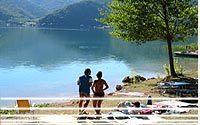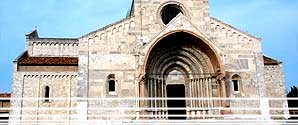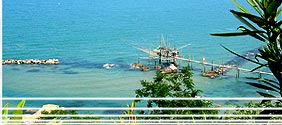 |
|
 |
City
of Ancona - Italy
| CITY
OF ANCONA
The city extends around the promontory of Mount
Conero. Ancona, i.e. the capital city of the region,
has got the most well-working port of the middle
Adriatic sea, as it is linked almost naturally
with Greece and Croatia.
In the city you can find very interesting monuments
such as:
-
Mole Vanvitelliana or
Laemocomium (the Mole of Vanvitelli)
-
Duomo di San Ciriaco (the
Cathedral of San Ciriaco)
-
Anfiteatro Romano (the
Roman Amphitheatre)
-
Palazzo Ferretti (Museo
Nazionale delle Marche) (Ferretti Palace-National
Museum of Marche)
-
Arco di Traiano and Arco
Clementino (Trajan Arch and Clementine Arch.
|
 |
| |
-
Mole Vanvitelliana or Laemocomium
(the Mole of Vanvitelli)
The Lazaretto (Laemocomium) of Ancona was
built by Architect Luigi Valvitelli in 1732.
It was built in order to ensure immunity
to epidemics which might have been spread
by goods and people from other countries.
Throughout the years the Lazaretto has been
used as a military hospital and barracks.
The Municipality is the owner of the Mole
since 1990 and has made it the heart of
the city as far as art and culture are concerned.
|
|
 |
| |
-
Duomo di San Ciriaco (the
Cathedral of San Ciriaco)
From the top of Guasco Hill the Cathedral
of San Ciriaco dominates the city and its
port. It is a medieval monument which was
built between XI and XIII century on the
base of a III-century B.C. Italic temple.
You enter the Cathedral through a wonderful
portal made of white and red stone; it is
a church with nave and two aisles separated
by Roman columns with Byzantine capitals.
Inside the Cathedral you can admire the
“monumento del Beato Ginelli”
(1509) (“monument of the Blessed Ginelli”)
whereas in the crypt you can see the remains
of the Italic temple.
|
|
 |
| |
-
Anfiteatro Romano (the Roman Amphitheatre)
The Roman Amphitheatre (I century A.D.),
located near the Cathedral of San Ciriaco,
is together with Arco di Traiano (Trajan
Arch), the most important monument bearing
witness to the Roman influence on the city
of Ancona.
The Amphitheatre, situated between Colle
dei Cappuccini (Cappuccini Hill) and Colle
Guasco (Guasco Hill) was built during the
Augustan Age; its seating capacity was 8,000.
Today you can still see remains of mosaic
floor, the front entrance and two back entrances. |
|
 |
| |
- Palazzo Ferretti (Ferreti
Palace-National Museum of Marche)
Palazzo Ferretti, built in 1560, is the
seat of the National Archaeological Museum.
It contains many finds dating back to the
Paleolithic and Iron Age, Greek finds, Hellenistic
sculptures, Roman mosaics and sculptures.
In addition, the Museum contains the popular
golden bronze statues by Cartoceto from
Pergola.
Palazzo Ferretti ‘s façade
is noteworthy. It is a work by Vanvitelli.
|
|
|
|
|
 |
 |
| Beach
hotels |
| the most beautiful beaches
of Italy in the best hotels |
|
|
|


